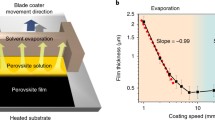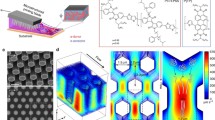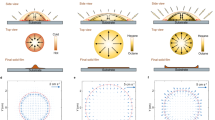Abstract
In the last decade, semiconducting and conducting materials were developed that can be processed by solvent-based deposition to form functional layers or complete electronic devices. These materials are typically synthesized in laboratory scale quantities and tested on small spin-coated substrates, whereas the final goal is to produce them on flexible substrates in a continuous roll-to-roll process. To enable a fast scale up and optimization, fluid-dynamic properties have to be known. Here, we present viscosity and surface tension data for typical material systems, applied in polymer-based solar cells. Materials presented include water-based polymer dispersions (hole-conducting and high-conductive PEDOT:PSS types), solvent-based anorganic nanoparticle dispersions (silver nanoparticle ink, hole-blocking ZnO nanoparticle ink), and dissolved organic molecules and polymers (P3HT:PCBM photoactive blend). Predictive models are proposed to approximate viscosity and surface tension for these materials at various compositions. As well, corona treatment is used to modify the surface energy of P3HT:PCBM and described as a function of web speed and corona power. The importance of material properties is demonstrated by predicting stable conditions for a slot-die coating process. A simple drying simulation highlights the possibility of using property models to investigate wetting problems.












Similar content being viewed by others
References
Brabec, CJ, Organic Photovoltaics Materials, Device Physics, and Manufacturing Technologies. Wiley-VCH, Weinheim, 2008
Peet, J, et al., “The Role of Processing in the Fabrication and Optimization of Plastic Solar Cells.” Adv. Mater., 21 (14–15) 1521–1527 (2009)
National Renewable Energy Laboratory, Research Cell Efficiency Records (2012)
Krebs, FC, et al., “A Complete Process for Production of Flexible Large Area Polymer Solar Cells Entirely Using Screen Printing—First Public Demonstration.” Sol. Energy Mater. Sol. Cells, 93 (4) 422–441 (2009)
Kopola, P, et al., “High Efficient Plastic Solar Cells Fabricated with a High-Throughput Gravure Printing Method.” Sol. Energy Mater. Sol. Cells, 94 1673–1680 (2010)
Blankenburg, L, et al., “Reel-to-Reel Wet Coating as an Efficient Up-Scaling Technique for the Production of Bulk-Heterojunction Polymer Solar Cells.” Sol. Energy Mater. Sol. Cells, 93 (4) 476–483 (2009)
Galagan, Y, et al., “Technology Development for Roll-to-Roll Production of Organic Photovoltaics.” Chem. Eng. Process., 50 (5–6) 454–461 (2011)
Park, HJ, et al., “A Facile Route to Polymer Solar Cells with Optimum Morphology Readily Applicable to a Roll-to-Roll Process Without Sacrificing High Device Performances.” Adv. Mater., 22 E247–E253 (2010)
Zimmermann, B, et al., “ITO-Free Flexible Inverted Organic Solar Cell Modules with High Fill Factor Prepared by Slot Die Coating.” Sol. Energy Mater. Sol. Cells, 95 (7) 1587–1589 (2011)
Steim, R, et al., “Organic Photovoltaics for Low Light Applications.” Sol. Energy Mater. Sol. Cells, 95 (12) 3256–3261 (2011)
Solenne BV, http://www.solennebv.com/price%20lists.htm, 2012
Wengeler, L, et al., “Comparison of Large Scale Coating Techniques for Organic and Hybrid Films in Polymer Based Solar Cells.” Chem. Eng. Process. (2012). doi:10.1016/j.cep.2012.03.004
Wengeler, L, et al., “Investigations on Knife and Slot Die Coating and Processing of Polymer Nanoparticle Films for Hybrid Polymer Solar Cells.” Chem. Eng. Process., 50 (5–6) 478–482 (2011)
Helgesen, M, Sondergaard, R, Krebs, FC, “Advanced Materials and Processes for Polymer Solar Cell Devices.” J. Mater. Chem., 20 (1) 36–60 (2010)
Macosko, C, Larson, R, Rheology: Principles, Measurements, and Applications. Wiley-VCH, New York, 1994
Yaws, C, Chemical Properties Handbook: Physical Thermodynamic, Environmental, Transport, Safety and Health Related Properties for Organic and Inorganic Chemicals. McGraw-Hill, New York, 1999
Gonzalez, B, et al., “Density, Dynamic Viscosity, and Derived Properties of Binary Mixtures of Methanol or Ethanol with Water, Ethyl Acetate, and Methyl Acetate at T = (293.15, 298.15, and 303.15) K.” J. Chem. Thermodyn., 39 (12) 1578–1588 (2007)
Dimitriev, OP, et al., “PEDOT:PSS Films—Effect of Organic Solvent Additives and Annealing on the Film Conductivity.” Synth. Met., 159 (21–22) 2237–2239 (2009)
Voigt, MM, et al., “Gravure Printing Inverted Organic Solar Cells: The Influence of Ink Properties on Film Quality and Device Performance.” Sol. Energy Mater. Sol. Cells, 105 77–85 (2012)
Teja, AS, Rice, P, “Generalized Corresponding States Method for the Viscosities of Liquid-Mixtures.” Ind. Eng. Chem. Fundam., 20 (1) 77–81 (1981)
Jasper, JJ, “The Surface Tension of Pure Liquid Compounds.” J. Phys. Chem. Ref. Data, 1 (4) 841–1010 (1972)
Connors, KA, Wright, JL, “Dependence of Surface Tension on Composition of Binary Aqueous-Organic Solutions.” Anal. Chem., 61 (3) 194–198 (1989)
Wolf, R, Sparavigna, AC, “Role of Plasma Surface Treatments on Wetting and Adhesion.” Engineering, 2 (6) 397–402 (2010)
Acknowledgments
We gratefully acknowledge the financial support of the Baden-Württemberg-Stiftung.
Author information
Authors and Affiliations
Corresponding author
Rights and permissions
About this article
Cite this article
Wengeler, L., Peters, K., Schmitt, M. et al. Fluid-dynamic properties and wetting behavior of coating inks for roll-to-roll production of polymer-based solar cells. J Coat Technol Res 11, 65–73 (2014). https://doi.org/10.1007/s11998-013-9483-5
Published:
Issue Date:
DOI: https://doi.org/10.1007/s11998-013-9483-5




